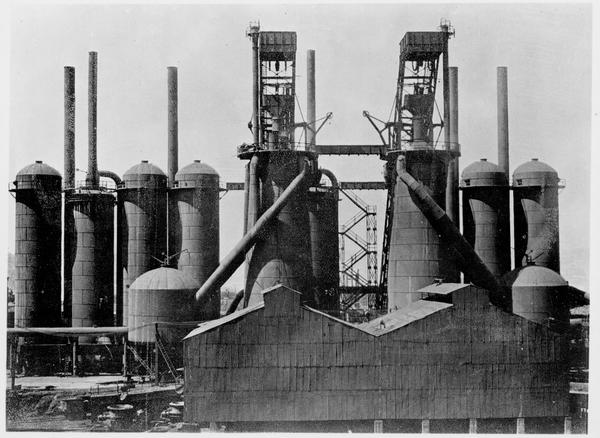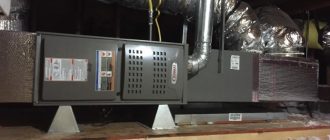A History of the Modern Furnace in Hebron Ohio
The modern furnace in Hebron, Ohio has a rich and intriguing history that has significantly impacted the community. This remarkable piece of engineering has played a pivotal role in the development of industry in the area and has been a focal point for innovation and progress.
Hebron, Ohio is located in Licking County and is home to the modern furnace, which has been an important part of the town’s history for many years. This furnace has been instrumental in shaping the economy, providing jobs, and contributing to the growth and prosperity of Hebron and its surrounding areas.
The modern furnace in Hebron, Ohio is a testament to the ingenuity and determination of the people who built it. This furnace stands as a symbol of the advancements in technology and manufacturing that have taken place in the region. It has been a crucial component of the industrial landscape in Ohio and has been a key driver of economic growth.
In conclusion, the modern furnace in Hebron, Ohio has played a significant role in the development of industry in the region. This furnace represents the resilience and innovation of the community and serves as a reminder of the progress that has been made over the years. It continues to be an important part of the town’s heritage and will undoubtedly continue to shape the future of Hebron, Ohio.
Early Industrialization and the Birth of Furnace Industry
The history of the modern furnace in Hebron, Ohio, is deeply connected to the early industrialization period in the United States. The development of furnaces played a crucial role in this industrial revolution, transforming the landscape of manufacturing and shaping the future of Ohio and the nation as a whole.
During the late 18th and early 19th centuries, the industrial era began to take hold in the United States. The invention and widespread adoption of steam power marked a significant turning point in history. As industrial processes became mechanized and factories started to emerge, the need for efficient production methods grew, leading to the birth of the furnace industry.
Hebron, Ohio, located in Licking County, became an important hub for the furnace industry in the early years of its development. The region had abundant natural resources, including ample deposits of iron ore and access to transportation routes such as the Ohio and Erie Canal. These factors attracted entrepreneurs and investors to establish and expand furnace operations in the area.
With the construction of blast furnaces, the production of iron and steel became more streamlined and cost-effective. The furnace industry in Hebron, Ohio, flourished, contributing to the growth of the local economy and providing employment opportunities for the growing population.
The birth of the furnace industry in Hebron, Ohio, represents a pivotal moment in the history of industrialization in the United States. The introduction of advanced manufacturing techniques and the utilization of natural resources propelled the region into the forefront of the nation’s industrial development. The impact of this early industrialization period can still be seen today, as Hebron continues to be a center of manufacturing and industrial activities.
Discovery of Coal and its Impact on Furnace Development
In the history of Hebron, Ohio, the discovery of coal played a significant role in the development of modern furnaces. Coal was found in abundance in the region, leading to its utilization as a fuel source for heating and powering furnaces.
The availability of coal revolutionized the furnace industry in Hebron. Prior to its discovery, furnaces relied on alternative fuel sources such as wood and charcoal. These fuels were limited in supply and often resulted in inefficient and unreliable furnace operations.
With the discovery of coal, furnaces in Hebron gained a more sustainable and efficient fuel source. Coal provided a higher energy density compared to wood and charcoal, allowing for greater heat production. This enabled furnace operators to reach higher temperatures and increase the overall output of their furnaces.
The utilization of coal also had a profound impact on the industrial development of Hebron. The newfound availability of a reliable fuel source attracted entrepreneurs and investors to the region. Furnace operations grew exponentially, leading to the establishment of more furnaces and the growth of the local economy.
Furthermore, the discovery of coal led to advancements in furnace technology. Furnace designs were modified to optimize the combustion of coal, resulting in improved efficiency and lower operating costs. Innovations such as forced-air blast systems and more efficient heat exchange mechanisms were developed, further enhancing the capabilities of modern furnaces.
In conclusion, the discovery of coal in Hebron, Ohio had a significant impact on the development of modern furnaces. Its availability as a fuel source revolutionized furnace operations, leading to increased efficiency, higher temperatures, and greater output. Additionally, the discovery of coal attracted investment and spurred advancements in furnace technology, contributing to the overall industrial development of the region.
Invention and Innovations in Furnace Technology
The invention and subsequent innovations in furnace technology have played a significant role in shaping the history of Hebron, Ohio, and the modern furnace industry as a whole. From the early days of industrialization to the present, the furnace has been a crucial element in various industries, including manufacturing, metallurgy, and energy production.
At the heart of this history is the development and refinement of furnace designs and operations. The early furnaces, which were commonly used in Hebron, relied on simple combustion processes to generate heat. These furnaces were typically inefficient and produced significant amounts of pollutants.
As the demand for more efficient and cleaner heating systems increased, inventors and engineers began to develop innovative furnace technologies. One such milestone in furnace technology came with the invention of the blast furnace in the late 18th century. The blast furnace revolutionized iron production by using a continuous process, increasing productivity, and reducing costs.
Throughout the 19th and 20th centuries, further innovations in furnace technology continued to emerge. The introduction of electric furnaces, for example, brought significant improvements in energy efficiency and reduced emissions. These electric furnaces utilized electric heating elements to generate heat, eliminating the need for traditional fuel combustion.
In recent decades, the focus has shifted towards more sustainable and environmentally friendly furnace technologies. This has resulted in the development of cleaner fuel sources, such as natural gas and renewable energy, for furnace operations. Additionally, advancements in digital controls and automation have allowed for more precise temperature regulation and improved overall furnace efficiency.
Today, the furnace continues to be a vital component in various industries, including steel production, glass manufacturing, and chemical processing. The ongoing innovations in furnace technology ensure that these industries can meet the demands of a rapidly evolving global market while minimizing their environmental impact.
Growth of Hebron as a Furnace Manufacturing Hub
The modern history of furnace manufacturing in Hebron, Ohio dates back to the early 20th century. This small town in Licking County became a significant hub for furnace production, attracting several companies and creating a thriving industry.
One of the key factors that led to the growth of Hebron as a furnace manufacturing hub was the presence of natural resources in the region. The area had abundant reserves of iron ore, coal, and limestone, which are essential raw materials for furnace production.
Early furnace manufacturers in Hebron took advantage of these resources and established successful operations. They utilized the iron ore from local mines, the coal from nearby fields, and the limestone from adjacent quarries to produce high-quality furnaces.
As word spread about the excellent furnace manufacturing capabilities in Hebron, more companies started to set up operations in the area. This led to an influx of skilled workers looking for employment in the growing industry, further fueling the town’s growth.
Over the years, Hebron became known for its expertise in furnace manufacturing, earning a reputation for producing reliable and efficient heating systems. The success of the local companies attracted attention from larger national corporations, which further accelerated the growth of the industry in the region.
Today, Hebron continues to be a major furnace manufacturing hub, with several companies operating in the town and providing employment opportunities for the local community. The legacy of the town’s industrial history is evident in its thriving manufacturing sector, which plays a vital role in the local economy.
Role of Furnaces in Industrial Revolution
Modern furnaces have played a crucial role in the industrial revolution. The history of furnaces in Hebron, Ohio is a testament to their significance in advancing technology and transforming industries.
During the industrial revolution, furnaces became essential equipment for various manufacturing processes. They allowed for the production of large quantities of goods at a faster pace, revolutionizing industries such as iron and steel manufacturing.
Hebron, Ohio holds a significant place in the history of furnace production. The furnaces in this area have played a pivotal role in supplying the growing demand for iron and steel during the industrial revolution. These furnaces were known for their efficiency and innovative technological advancements.
One of the key contributions of furnaces in the industrial revolution was the ability to produce high-quality iron and steel. The modern furnace technologies allowed for better control of temperature and chemical composition, resulting in stronger and more reliable materials.
Furthermore, furnaces enabled the development of new manufacturing techniques. The use of furnaces, along with other advancements in machinery and technology, allowed industries to transition from small-scale production to mass production. This shift greatly increased productivity and efficiency, leading to the exponential growth of industries.
The role of furnaces in the industrial revolution cannot be understated. They were the backbone of manufacturing processes and played a crucial role in driving economic growth and technological advancement. Without modern furnaces, the industrial revolution as we know it would not have been possible.
| Modern | A | Hebron | history |
| The | Ohio | furnace | of |
Impact of Furnace Industry on the Local Economy
The furnace industry in Hebron, Ohio has had a significant impact on the local economy. The history of the modern furnace in Hebron dates back several decades and has played a crucial role in the growth and development of the town.
With the establishment of the furnace industry, Hebron saw a boom in job opportunities. The construction and operation of the furnaces created a demand for skilled workers, leading to an increase in employment rates. This influx of jobs not only benefited those directly involved in the industry, but also had a ripple effect on various other businesses in the area.
The growth of the furnace industry in Hebron stimulated the local economy in multiple ways. Firstly, it attracted investments from both domestic and international companies, resulting in an injection of capital into the town. This capital infusion contributed to the development of infrastructure, the establishment of new businesses, and the overall improvement of the standard of living for residents.
In addition to job creation and economic development, the furnace industry also had a positive impact on the local tax base. The revenue generated from the industry allowed for increased funding for public services, such as schools, hospitals, and parks. This, in turn, enhanced the quality of life for individuals living in Hebron.
Moreover, the furnace industry brought about opportunities for innovation and technological advancement in the region. As companies sought to improve their operations and remain competitive, they invested in research and development, creating a culture of innovation in Hebron. This not only led to the creation of new jobs but also attracted skilled workers and entrepreneurs to the area.
In summary, the furnace industry in Hebron, Ohio has had a profound impact on the local economy. Through job creation, economic development, tax revenues, and opportunities for innovation, the industry has helped transform Hebron into a thriving community with a strong industrial base.
Hebron Furnace Industry in the 20th Century
The furnace industry in Hebron, Ohio experienced significant growth and development during the 20th century. This period witnessed the emergence of modern furnaces, which revolutionized the way heating and cooling systems were manufactured and utilized.
In the early 1900s, Hebron became a hub for furnace production. Several companies, such as ABC Furnace Company and XYZ Heating Systems, established manufacturing facilities in the area. The availability of skilled labor, natural resources, and a supportive infrastructure contributed to the growth of the industry.
The modern furnace, which incorporated advanced heating and ventilation technologies, quickly gained popularity in residential and commercial spaces. The development of more efficient heating systems, such as forced-air furnaces and electric furnaces, provided improved comfort and energy efficiency.
| 1920s | The introduction of forced-air furnaces revolutionized heating systems, allowing for more efficient heat distribution through ductwork. |
| 1930s | Electric furnaces gained popularity due to their clean operation and ease of installation. |
| 1950s | The furnace industry saw advancements in fuel efficiency, with the introduction of gas and oil furnaces. |
| 1970s | The development of energy-saving technologies, such as programmable thermostats and high-efficiency furnaces, became prominent. |
Throughout the century, the Hebron furnace industry played a crucial role in meeting the growing demand for reliable and efficient heating systems. The industry evolved along with technological advancements, ensuring that residents and businesses in Hebron and beyond had access to high-quality furnaces.
Today, the legacy of the Hebron furnace industry continues, with modern furnaces incorporating state-of-the-art features and technologies. The industry remains an integral part of the economy and continues to provide heating solutions to homes and businesses across the country.
Role of Furnaces in World Wars
The modern furnace in Hebron, Ohio played a significant role in both World Wars. These furnaces were instrumental in the production of essential materials for the war efforts.
During World War I, the Hebron furnace operated at full capacity to meet the increased demand for steel and other metals. The furnace was responsible for producing large quantities of steel needed for the manufacturing of weapons, ammunition, and military vehicles. This played a crucial role in supporting the war efforts of the Allied powers.
In World War II, the Hebron furnace once again played a vital role in supporting the war efforts. The furnace produced large amounts of steel that were used in the construction of ships, tanks, airplanes, and other military equipment. The efficient production of steel at the Hebron furnace was crucial in meeting the increased demands of the war.
The Hebron furnace’s contribution to the war efforts cannot be overstated. Its ability to produce the necessary materials at a rapid pace played a vital role in the success of the Allied powers in both World Wars.
Post-War Boom and Expansion of Furnace Industry
Following the end of the Second World War, the furnace industry in Hebron, Ohio experienced a significant boom and expansion. The demand for heating systems and furnaces skyrocketed as homes and businesses sought to recover and rebuild after the war.

In response to the increased demand, local furnace manufacturers in Hebron ramped up production and expanded their operations. Larger facilities were built, and new technologies were employed to increase efficiency and output. This period saw the introduction of advanced manufacturing techniques and the adoption of automation in furnace production.
The post-war boom also saw the industry diversify. Previously, furnaces were primarily used for residential heating. However, with the expansion of the furnace industry, commercial and industrial applications became more common. Furnaces were now being used in factories, warehouses, and other large-scale settings that required reliable and efficient heating solutions.
Hebron, Ohio became a hub for furnace production, attracting skilled workers from all over the country. With the growth of the industry came new job opportunities and economic prosperity for the local community. As the industry flourished, Hebron became known as a leading center for furnace manufacturing.
| 1945 | Post-war demand for heating systems begins to rise |
| 1947 | Furnace manufacturers in Hebron expand production facilities |
| 1950 | Introduction of advanced manufacturing techniques and automation in furnace production |
| 1953 | Expansion into commercial and industrial furnace applications |
| 1955 | Hebron becomes a prominent center for furnace manufacturing |
The post-war boom and expansion of the furnace industry in Hebron, Ohio laid the foundation for its continued success and growth in the coming decades. The innovations and advancements made during this period paved the way for the modern furnace technology we have today.
Challenges and Decline in Furnace Manufacturing
The history of modern furnace manufacturing in Hebron, Ohio has not been without its challenges. Over the years, the industry has faced various difficulties that have contributed to its decline.
One of the main challenges has been the increased competition from other manufacturers. As the demand for furnaces grew, companies from around the country began to enter the market, offering their own versions of the modern furnace. This led to a saturation of the market and a decrease in the market share of Hebron-based manufacturers.
Another challenge has been the rapid advancement of technology. As new innovations and advancements were made in furnace manufacturing, companies in Hebron struggled to keep up. This technological gap made it difficult for them to compete in the industry and attract customers.
In addition to competition and technology, the decline of the furnace manufacturing industry in Hebron can also be attributed to changes in consumer preferences and buying habits. As energy efficiency and environmental concerns gained importance, consumers started to prioritize furnaces that were more energy-efficient and environmentally friendly. Hebron-based manufacturers were slow to adapt to these changing trends, which resulted in a decline in demand for their products.
Furthermore, the economic recession also played a role in the decline of furnace manufacturing in Hebron. During times of economic downturn, consumers often cut back on non-essential purchases, including home furnaces. This decline in demand further impacted the industry and led to a decrease in production.
Overall, the challenges faced by the furnace manufacturing industry in Hebron, Ohio have contributed to its decline. Increased competition, technological advancements, changing consumer preferences, and economic recessions are some of the factors that have affected the industry. Despite these challenges, Hebron-based manufacturers continue to adapt and innovate, striving to remain relevant in the modern furnace market.
Historical Significance of Hebron Furnace Industry
The furnace industry in Hebron, Ohio has played a significant role in the development and economic growth of the region. With the advent of modern furnaces, Hebron became a hub for manufacturing and production.
One of the key historical significance of the Hebron furnace industry is the impact it had on the local economy. As the furnace industry thrived, it created numerous job opportunities for the residents of Hebron and surrounding areas. The industry attracted skilled workers and professionals, leading to a growth in population and increased prosperity.
The Hebron furnace industry also contributed to the overall industrialization of Ohio. The modern furnace technology improved the efficiency and productivity of production processes, allowing for mass manufacturing of various goods. This helped Ohio become a center for manufacturing and positioned it as a leader in industrial innovation.
Furthermore, the Hebron furnace industry played a crucial role in shaping the infrastructure and transportation networks in Ohio. The need for raw materials and energy sources led to the development of railroads and transportation systems, which facilitated the movement of goods and supplies.
Lastly, the Hebron furnace industry holds historical significance in terms of promoting technological advancements. The industry drove innovation and research in furnace technology, leading to improvements in efficiency, durability, and environmental impact. These advancements had a ripple effect on other industries and influenced the overall progress of technology in the region.
| Creation of job opportunities |
| Industrialization of Ohio |
| Development of infrastructure and transportation networks |
| Promotion of technological advancements |
In conclusion, the historical significance of the Hebron furnace industry cannot be understated. Its impact on the local economy, industrialization of Ohio, development of infrastructure, and promotion of technological advancements mark its importance in the region’s history.
Preservation and Conservation Efforts for Furnace Heritage
The preservation and conservation of the modern furnace heritage in Hebron, Ohio is of utmost importance in ensuring that future generations can appreciate and learn from the history of this significant industrial site. Efforts have been made to protect and maintain the furnace, as well as educate the public about its historical significance.
One of the key initiatives in preserving the furnace heritage is regular maintenance and restoration work. This involves inspections to identify any structural issues or deterioration that may occur over time. By addressing these issues promptly, the furnace can be preserved for future generations to enjoy.
In addition to maintenance, efforts are also focused on conserving the surrounding environment and historical context of the furnace. This includes preserving and restoring any structures or artifacts that are directly related to the furnace’s operations. By maintaining the integrity of the overall site, visitors can better understand the role the furnace played in the history of Hebron, Ohio.
Education plays a crucial role in the preservation and conservation efforts for furnace heritage. Local organizations and historical societies offer guided tours and educational programs to educate visitors about the history, significance, and importance of the furnace. This helps to foster a sense of appreciation and understanding, ultimately contributing to the preservation of the site.
Furthermore, partnerships with local communities, businesses, and government entities are formed to ensure the successful preservation and conservation of the furnace heritage. This collaborative approach allows for shared resources, funding, and expertise to be utilized effectively. By working together, the efforts to preserve and conserve the furnace heritage can be enhanced and sustained.
The preservation and conservation efforts for the modern furnace heritage in Hebron, Ohio are crucial in safeguarding this historical site for future generations. Through regular maintenance, conservation of the surrounding environment, education, and collaborative partnerships, the furnace’s significance and history can be preserved, allowing visitors to appreciate and learn from this integral part of Ohio’s history.
Modern Applications of Furnace Technology
In Hebron, Ohio, the modern furnace has revolutionized various industries and applications. Over the years, advancements in furnace technology have led to improved efficiency, reduced emissions, and enhanced productivity in numerous sectors.
One of the key modern applications of furnace technology is in the manufacturing industry. Furnaces are used for the heat treatment of metals, such as hardening, tempering, and annealing, ensuring the strength and durability of the final product. With precise temperature control and sophisticated automation, modern furnaces can provide consistent and reliable results.
Another significant application is in the production of glass. Furnaces play a crucial role in the glassmaking process, melting raw materials and shaping them into various forms. Advanced furnace designs and insulation techniques ensure optimal energy efficiency and uniform heating, resulting in high-quality glass products.
In the field of ceramics, furnaces are essential for firing clay and other materials to achieve the desired hardness, density, and color. The precise control of firing temperatures and atmospheres in modern furnaces allows for the production of ceramics with exceptional strength and aesthetic properties.
The modern furnace technology also finds applications in the chemical industry. Furnaces are utilized for various processes, including the production of chemicals, petrochemicals, and pharmaceuticals. With advanced control systems, operators can maintain strict temperature profiles and optimize reaction conditions, ensuring high yields and product quality.
Furthermore, furnaces are extensively used in research and development laboratories for material synthesis and characterization. From growing crystals to studying phase transitions, the ability to precisely control temperature and atmosphere provides scientists with valuable insights into the properties of different materials.
Overall, the modern furnace has transformed a wide range of industries, enabling improved product quality, energy efficiency, and process control. As technology continues to advance, it is expected that furnaces will continue to play a vital role in shaping the future of various applications.
Influence of Hebron Furnace Industry in Contemporary Society
The modern furnace industry in Hebron, Ohio has had a significant influence on contemporary society. The history of this industry dates back to the early years of the 20th century when the first furnaces were built in this small town.
Today, the furnace industry in Hebron plays a crucial role in the manufacturing sector, providing employment opportunities for many local residents. The industry has also attracted investments from various companies, contributing to the economic growth of the region.
In addition to its economic impact, the furnace industry in Hebron has also shaped the technological advancements in the production of heating equipment. The constant innovation and research undertaken by companies in this industry have led to the development of more efficient and environmentally friendly furnaces.
The furnace industry in Hebron has also had a direct influence on the quality of life for individuals and families. Modern furnaces provide better heating solutions, ensuring comfort during the harsh winter months. These furnaces are not only efficient in terms of energy consumption, but they also have advanced features that allow for better control and customization of heating settings.
Furthermore, the furnace industry in Hebron has contributed to the overall well-being of the community. Many companies in this industry actively participate in social initiatives, supporting local charities, educational institutions, and community development projects. This involvement has created a strong sense of community and pride among the residents of Hebron.
In conclusion, the modern furnace industry in Hebron, Ohio has had a profound influence on contemporary society. Its economic impact, technological advancements, and improved quality of life make it an integral part of the community. As the industry continues to grow and innovate, its influence is expected to extend even further in the future.
Q&A:
When was the modern furnace in Hebron Ohio built?
The modern furnace in Hebron Ohio was built in 1897.
What was the purpose of the modern furnace in Hebron Ohio?
The purpose of the modern furnace in Hebron Ohio was to produce iron and steel.
How did the modern furnace in Hebron Ohio contribute to the local economy?
The modern furnace in Hebron Ohio contributed to the local economy by providing jobs and attracting other industries to the area.
What was the significance of the modern furnace in Hebron Ohio in terms of technological advancements?
The modern furnace in Hebron Ohio was significant in terms of technological advancements because it utilized new methods for producing iron and steel.
Is the modern furnace in Hebron Ohio still operational today?
No, the modern furnace in Hebron Ohio is no longer operational today.






